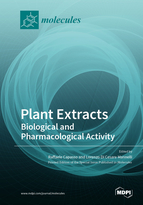Plant Extracts: Biological and Pharmacological Activity
A special issue of Molecules (ISSN 1420-3049). This special issue belongs to the section "Natural Products Chemistry".
Deadline for manuscript submissions: closed (1 April 2020) | Viewed by 320268
Special Issue Editors
Interests: pharmacology; natural products; neurotransmission; behavioral pharmacology; experimental pharmacology; preclinical pharmacology; CB1 receptor; PPARs; cannabinoids; endocannabinoids; CB2 receptor
Special Issues, Collections and Topics in MDPI journals
Interests: pharmacology; medicinal plants; chronic pain; nervous system pathologies and treatment; glia; cholinergic receptors; opioid receptors
Special Issues, Collections and Topics in MDPI journals
Special Issue Information
Dear Colleagues,
The use of plant extracts in therapy dates back many years. Plant extracts have been commonly used over the years for the treatment and prevention of chronic and acute diseases, and health promotion.
Although many plant extracts have been studied, many others have not, therefore, a Special Issue on the pharmacology of plant extracts is timely.
This Special Issue aims to comprehensively highlight the newest discoveries in plant extract products with an emphasis on pharmacological activity.
I cordially invite authors to contribute original articles, as well as reviews, that unravel new biological activity of naturally-occurring products to help create greater opportunities for their future use.
Dr. Raffaele Capasso
Dr. Lorenzo Di Cesare Mannelli
Guest Editors
Manuscript Submission Information
Manuscripts should be submitted online at www.mdpi.com by registering and logging in to this website. Once you are registered, click here to go to the submission form. Manuscripts can be submitted until the deadline. All submissions that pass pre-check are peer-reviewed. Accepted papers will be published continuously in the journal (as soon as accepted) and will be listed together on the special issue website. Research articles, review articles as well as short communications are invited. For planned papers, a title and short abstract (about 100 words) can be sent to the Editorial Office for announcement on this website.
Submitted manuscripts should not have been published previously, nor be under consideration for publication elsewhere (except conference proceedings papers). All manuscripts are thoroughly refereed through a single-blind peer-review process. A guide for authors and other relevant information for submission of manuscripts is available on the Instructions for Authors page. Molecules is an international peer-reviewed open access semimonthly journal published by MDPI.
Please visit the Instructions for Authors page before submitting a manuscript. The Article Processing Charge (APC) for publication in this open access journal is 2700 CHF (Swiss Francs). Submitted papers should be well formatted and use good English. Authors may use MDPI's English editing service prior to publication or during author revisions.
Keywords
- plant extracts
- medicinal plants
- biological activity
- medical use
- plant side effects
- pharmacological interactions








